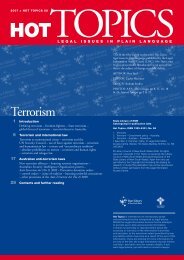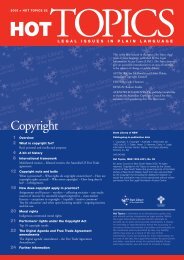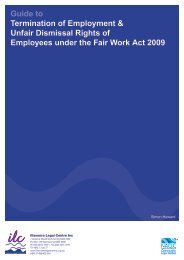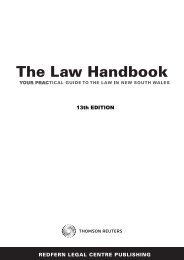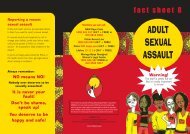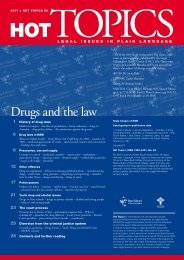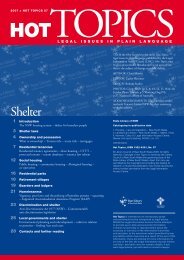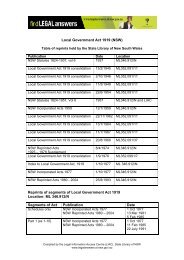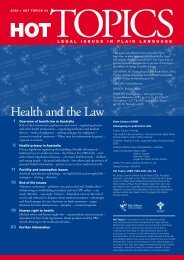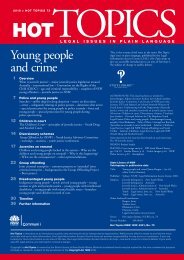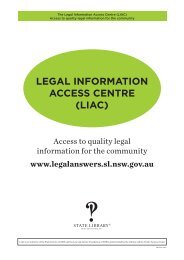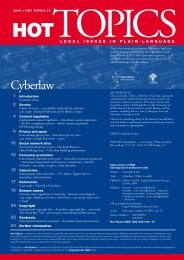Aboriginal people and the law - Legal Information Access Centre
Aboriginal people and the law - Legal Information Access Centre
Aboriginal people and the law - Legal Information Access Centre
Create successful ePaper yourself
Turn your PDF publications into a flip-book with our unique Google optimized e-Paper software.
2 <strong>Aboriginal</strong> <strong>people</strong> <strong>and</strong> <strong>the</strong> <strong>law</strong> 73The “<strong>Aboriginal</strong>” art <strong>Aboriginal</strong>s didn't makeIn August 2008, <strong>the</strong> Australian Competition <strong>and</strong> ConsumerCommission (<strong>the</strong> ACCC) found that a Queensl<strong>and</strong><strong>Aboriginal</strong> art dealer was in breach of s 52 for misleading<strong>and</strong> deceptive conduct. The <strong>Aboriginal</strong> art dealer sold art<strong>and</strong> artefacts made by non-<strong>Aboriginal</strong> artists <strong>and</strong> represented<strong>the</strong>m as being made by <strong>Aboriginal</strong> artists. TheFederal Court granted injunctions by consent restraining<strong>the</strong> art dealers, for a period of five years, from engagingin similar conduct <strong>and</strong> ordered <strong>the</strong>m to pay <strong>the</strong> ACCC'scosts. The art dealers were fur<strong>the</strong>r ordered to write tocertain purchasers of artworks produced by any of <strong>the</strong>three non-<strong>Aboriginal</strong> artists, advising <strong>the</strong>m of <strong>the</strong> courtproceedings. The art dealers also have offered <strong>the</strong> ACCCa court-enforceable undertaking that <strong>the</strong>y will implementa trade practices <strong>law</strong> compliance program (ACCC vNooravi [2008] FCA 2021).In December 2009, in ACCC v Australian DreamtimeCreations Pty Ltd 263 ALR 487, Justice Mansfield in <strong>the</strong>Federal Court found that Australian Dreamtime CreationsPty Ltd (“Dreamtime Creations”) misled consumers bymaking misleading representations about artworks usingIndigenous art styles. The Court held that DreamtimeCreations breached s 52 of <strong>the</strong> Trade Practices Actwhich prohibited corporations from engaging in misleadingor deceptive conduct. The Court found that <strong>the</strong>company's sole director, Tony Antoniou, was knowinglyconcerned in <strong>the</strong> conduct, <strong>and</strong> made orders designed toprevent both Dreamtime Creations <strong>and</strong> Mr. Antonioufrom engaging in similar conduct in <strong>the</strong> future.In <strong>the</strong> Dreamtime Creations case, <strong>the</strong> company promoted<strong>and</strong> sold a large quantity of artworks that wererepresented to be <strong>Aboriginal</strong> art painted by an artistcalled “Ubanoo Brown”. In reality <strong>the</strong> artworks were notpainted by Ubanoo Brown but ra<strong>the</strong>r a person ofnon-<strong>Aboriginal</strong> descent engaged by Mr Antoniou. Artgalleries were supplied with “Certificates of Au<strong>the</strong>nticity”that used terms such as “Au<strong>the</strong>ntic <strong>Aboriginal</strong>Painting”, “<strong>Aboriginal</strong> Fine Art Canvas” <strong>and</strong> “Artist:Ubanoo Brown”. Some artworks also had stamps affixedto <strong>the</strong>m that said ei<strong>the</strong>r “Traditional H<strong>and</strong> Painted<strong>Aboriginal</strong> Art Australia” or “Au<strong>the</strong>ntic Australian <strong>Aboriginal</strong>Art”.Whilst <strong>the</strong> CCA will provide assistance incases where <strong>the</strong> manufacturer or retailer ismaking clear assertions that work whichwas made by non-<strong>Aboriginal</strong> artists is “<strong>Aboriginal</strong>”or “au<strong>the</strong>ntic <strong>Aboriginal</strong> art” itwill not assist when <strong>the</strong> circumstances arenot so clear-cut. In <strong>the</strong> Australian DreamtimeCreations case a wooden bird that was carvedoverseas, imported into Australia with <strong>the</strong>artwork added here could still be sold as“made in Australia” if <strong>the</strong> work was sufficientlytransformed through <strong>the</strong> applicationof painted decoration. Ra<strong>the</strong>r than assistingIndigenous crafts persons, some provisionsof <strong>the</strong> CCA make <strong>the</strong> situation even murkier.[2.540] Better protection ofIndigenous cultural <strong>and</strong>intellectual property (ICIP) isstill neededIn 1997, <strong>the</strong> <strong>Aboriginal</strong> <strong>and</strong> Torres StraitIsl<strong>and</strong>er Commission <strong>and</strong> <strong>the</strong> AustralianInstitute for <strong>Aboriginal</strong> <strong>and</strong> Torres StraitIsl<strong>and</strong>er Studies commissioned a seminalreport on Indigenous cultural <strong>and</strong> intellectualproperty rights. The independent reportby Terri Janke was released in 1999 as OurCulture: Our Future – Report on AustralianIndigenous Cultural <strong>and</strong> Intellectual PropertyRights. It found that existing cultural heritage<strong>and</strong> intellectual property <strong>law</strong>s do notadequately protect Indigenous interests, <strong>and</strong>argued that:• Indigenous Australians have a comprehensiveview of cultural <strong>and</strong> intellectualproperty as including:– literary, performing <strong>and</strong> artistic works– scientific, agricultural <strong>and</strong> technicalknowledge– language– human remains– documentation of Indigenous <strong>people</strong>’sheritage in archives, films, photographs<strong>and</strong> new media• <strong>the</strong> principles underlying ownership <strong>and</strong>control of cultural <strong>and</strong> intellectual propertyrelating to communal ownership,cultural integrity <strong>and</strong> consent proceduresare consistent across Indigenous groups• Indigenous Australians are concernedabout increasing dem<strong>and</strong>s for Indigenouscultural <strong>and</strong> intellectual property, <strong>and</strong>that due to <strong>the</strong>se dem<strong>and</strong>s <strong>and</strong> to newtechnology, <strong>the</strong>ir cultures are being exploitedbeyond <strong>the</strong>ir control• current intellectual property <strong>law</strong> is inadequatein protecting Indigenous cultural<strong>and</strong> intellectual property



